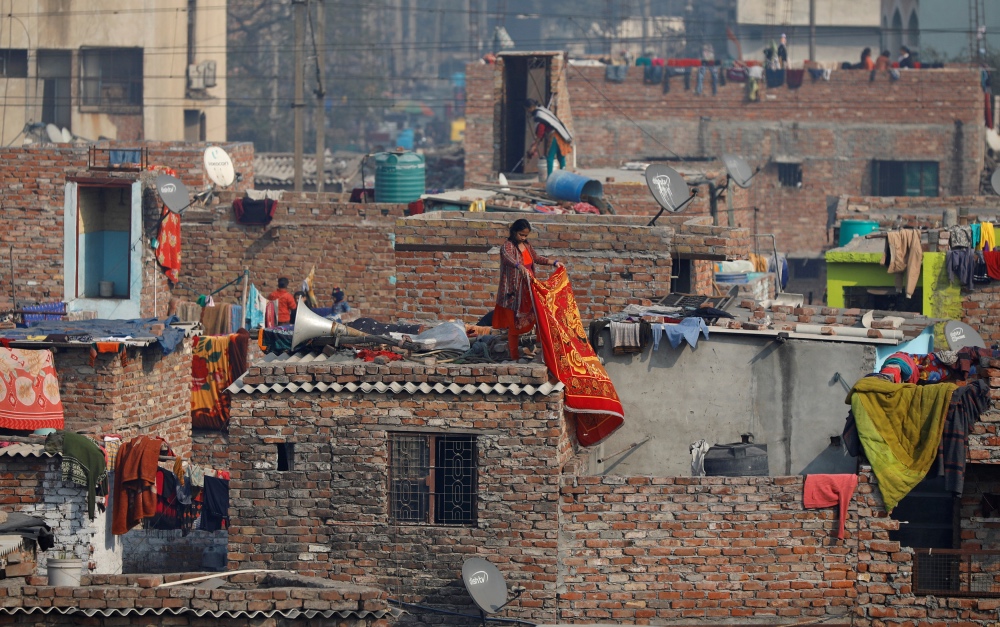Delhi, India
Thomson Reuters Foundation
The first coronavirus death in one of Asia’s largest slums has fuelled concerns of the virus spreading unchecked in places where people live cheek by jowl, with aid agencies racing to prepare for the worst.
Dharavi, a sprawling slum in Mumbai housing about one million people, reported its first death from COVID-19 and six other people have since tested positive, with the death described as “the tip of an iceberg”.

A woman hangs a blanket out to dry, at a slum in New Delhi, India, on 2nd January. PICTURE: Reuters/Danish Siddiqui
India has been under lockdown since 24th March to combat the spread of the coronavirus, which has infected about 5,300 and killed 150 so far in the nation of about 1.3 billion.
Health experts have warned it would be “impossible” to stop the fast-moving virus in squalid conditions in poorer countries in Asia and Africa where social distancing is difficult, clean water often scarce, sanitation poor and illnesses rife.
Kiran Dighavkar, an official with Mumbai’s municipality overseeing measures to contain COVID-19 in the locality, said advice over social distancing to limit the transmission of the virus could not be applied in Dharavi.
Dharavi is home to migrants from across India who live in tarpaulin-covered shacks, one-room brick tenements and multi-storied buildings in slum that covers over 240 hectares – the equivalent of nearly 450 US football fields.
“It is practically impossible,” he said, adding often up to 15 people live in one room and hundreds share water and toilets.
With growing numbers expected to step out of cramped homes to beat the summer heat or to buy food and medicine, he said tracing the route of the virus would be a nightmare.
“God forbid if any of them go out…and they get infected or they infect somebody. It will be very difficult to find out the containment zone or seal the area,” he said.
Poor living conditions, malnutrition and weakened immune systems make slum dwellers prone to contracting a more severe forms of the virus, said diseases expert Ramanan Laxminarayan.
“They are also less likely to be able access treatment,” said Laxminarayan, director of the Washington DC-based Center for Disease Dynamics, Economics and Policy.
He described the Dharavi death as “the tip of the iceberg”.
Things to do
Aid agencies worried about the impact on tens of millions of people in informal settlements and refugee camps from Bangladesh to Greece and across Africa were gearing up for the coronavirus.
In refugee settlements by Cox’s Bazar in Bangladesh, up to a dozen people share tents and many more use the same water wells and toilets in the camps that house more than one million Rohingya, members of a mostly Muslim minority who fled Myanmar.
Although no COVID-19 cases have been reported yet, medics have set up isolation units in hospitals and are teaching children about cleanliness, while the United Nations has trained health staff to detect the infection.
In Dharavi, hundreds of officers, community health workers and volunteers have been spreading awareness about COVID-19.
Dighavkar said testing was underway on the contacts of infected people and a 300-bed ward ready for “high-risk people”.
Dr David Nabarro, a special envoy to the World Health Organization on COVID-19, said these were some of the best steps to take in such places where isolating individuals and even whole households was challenging.
He said one of the last options was to lock down whole sections of a settlement with advice from local leaders – a measure that did well during his time tackling Ebola in West Africa – and speak and respond to people about their concerns.
“Women in particular often are nervous, particularly if they are not able to have privacy for keeping clean,” Nabarro told the Thomson Reuters Foundation via a video call.
“Ticking health bomb”
The UN has warned that almost 70 million people uprooted by war and persecution around the world are in acute danger.
Like in Asia and the Middle East, similar challenges run from Burkina Faso in western Africa to Somalia in the east, where violence and natural disasters have displaced millions.
Neighbouring Kenya is home to nearly half a million registered refugees, according to the UN data.
There have been no reported cases in East Africa camps so far but the UNHCR has been training health workers and running a hotline for refugees to report symptoms while also increasing soap distribution and creating more hand-washing stations.
UNHCR, the UN agency charged with protecting refugees, is looking to raise $US255 million from member states, part of a wider UN response plan seeking about $US2 billion.
On Sunday, Greece quarantined a second migrant facility after a man tested positive for COVID-19. Last week, it sealed its first camp after some 20 asylum-seekers were found infected.
More than 40,000 asylum-seekers are stuck in overcrowded refugee camps on the Greek islands, in conditions which the government itself has described as a “ticking health bomb”.
Laxminarayan urged mass testing to identify and prioritise high-risk populations, saying that other than lockdowns nothing specific was “being done at scale to protect these populations”.
Idlib province in Syria, with a population of nearly three million, received about 1,500 coronavirus testing kits last month. So far 20 cases have been detected there and two deaths.
But WHO’s Nabarro explained that widespread testing was not immediately possible given its complicated process, which involves sophisticated machines in labs.
“It would be wonderful if there were enough tests and testing facilities but…practically it is really, really difficult to do,” he said.






